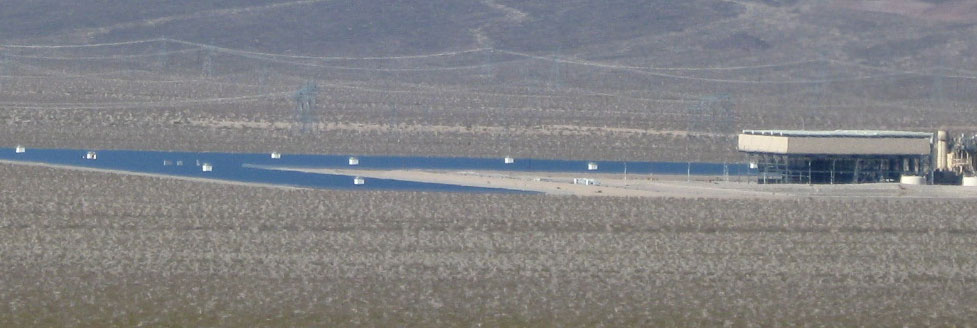^The El Dorado Valley photovoltaic farm in January 2009, with a natural gas-burning power plant next to it.
Why Can't This Go On Our Homes?
UPDATE: December 18, 2009 - Sempra Generation announced it will sell the electricity from its planned 48-megawatt thin-film photovoltaic Copper Mountain solar plant to Pacific Gas & Electric in northern California. The plant would use almost 1 million thin-film photovoltaic cells from Arizona-based First Solar, covering Mojave Desert scrub land. The California Public Utilities Commission approved the deal in which PG&E will buy over the next 20 years the entire output solar plant in the Boulder City, Nevada, "green zone." Story in San Diego Union-Tribune >>here.
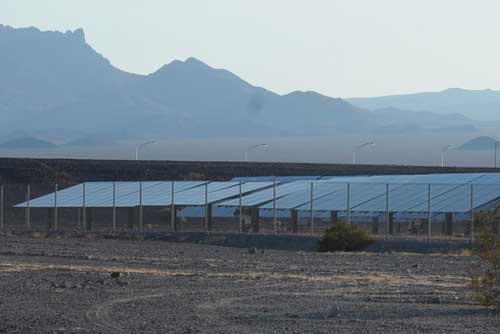
^Thin-film cadmium-telluride panels in a corner of the plant; note how the creosote desert is scraped bare and the area fenced. February 3, 2010.
^The current photovoltaic field next to Eldorado natural gas plant. You can make out an area of darker earth-grading on the lower left from the field. This is the expansion area of new grading. February 3, 2010.
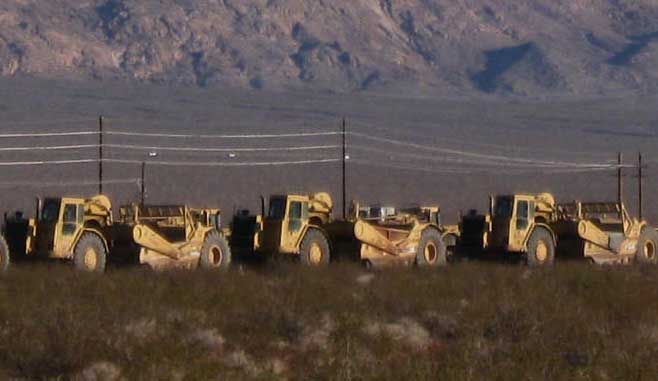
^Scraper-graders lined up ready for work. Solar projects in the desert do not always have a light touch. February 3, 2010.
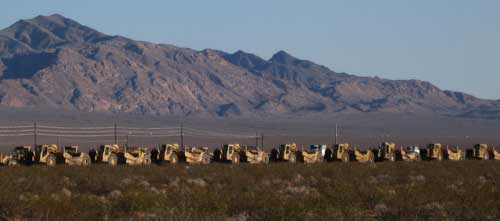
^About 20 scraper-graders used for the thin-film expansion on this creosote flat. The Piute-Eldorado Area of Critical Environmental Concern for Desert tortoise lies several miles to the south of this project. The Highland Range rises in the distance, a Crucial Bighorn Habitat Area. February 3, 2010.
January 22, 2009 - Boulder City, Nevada
A new power plant opened in southern Nevada today, attended by Governor Jim Gibbons (R), who hailed it as a tax-generator for the state and county, even as all the electricity it generates will be shipped off along nearby transmission lines snaking across the mountains from Hoover Dam, to Pacific Gas and Electric of central and northern California 800 miles away. None of the electricity will remain in Nevada. The power plant is located near the California border in Clark County, about 20 miles south of Las Vegas.
Sempra Generation, a subsidiary of Sempra Energy in San Diego, opened the plant today. The farm generates 10 megawatts, said to be enough to power 6,400 homes. We ask, why not place the PV panels on the rooftops of that many homes and localize power generation at the source? The solar farm uses photovoltaic panels similar to those mounted on homeowners’ roofs, except the panels are anchored to the cleared ground in long rows.
Sempra constructed the project on 80 acres next to its El Dorado Energy 480 megawatt natural gas-fired power plant. The environmental costs of this so-called "green energy" were not addressed in the news releases. 80 acres of pristine creosote-bursage desert had to be scraped and bulldozed bare to place the rows of PV panels, once home to Desert tortoises, Burrowing owls, Black-throated sparrows, Loggerhead shrikes, and many others. The TV news proclaimed that "less government red tape" allowed the plant to be built quickly, toward Nevada's goal of 1% renewable energy by 2010 (does this mean that any federally endangered species were swept under the rug?). Much of the land in El Dorado Valley is part of the large "green belt" around Boulder City, which is fast becoming an industrial "green energy" belt around the town by the Colorado River.
On their own website, Sempra calls this photovoltaic operation a "demonstration project," "to increase public awareness of and create interest in solar energy." (Does this mean it is not yet profitable?) The company will not disclose the price tag for building this PV plant, calling it "proprietary for competitive reasons."
Sempra is seeking to increase the plant to 58 megawatts. The company would rename the expanded project Copper Mountain Solar. But first it must find willing buyers of this peaker electricity from utilities. So far the local Nevada utility, NV Energy, is not interested. The combined plant would employ three people upon completion.

^In 2008 workers scraped the desert bare in El Dorado Valley, ready to place rows of solar panels.
Another secret is that these photovoltaic plants are built next to conventional carbon-spewing natural gas-burning power plants that continue to operate. The solar power plants are a small add-on to the base power of the large fossil fuel plants. Sempra plans to install an additional 50 megawatts of solar panels at the El Dorado site, and will carry out a much bigger project of about 500 megawatts adjacent to its Mesquite natural gas-burning plant near Phoenix. Sempra says, "It generates clean, emissions-free solar power during periods of peak electric demand." (Read more about how renewable energy such as wind must be backed up by coal/natural gas power >>here)
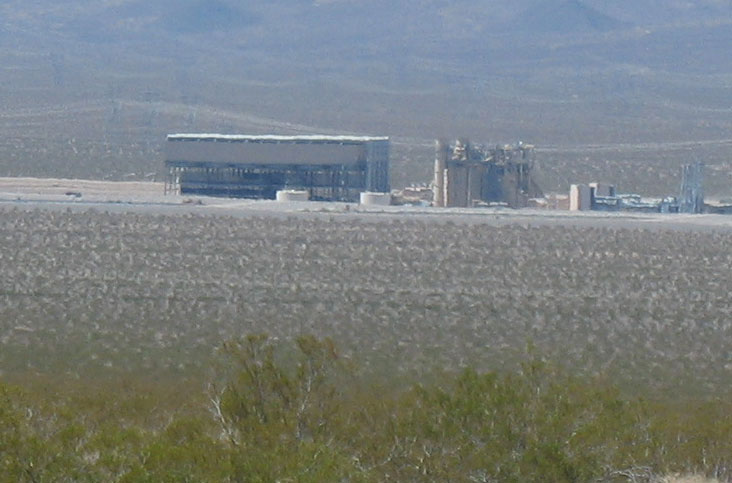
^The 480 MW natural gas-fired power plant in El Dorado Valley, August 2008. Note the bare dirt scrape to the left: this was creosote desert and was in the process of becoming the Sempra PV plant.
By 2011 Boulder City hopes to sign a contract with NextLight Renewable Power LLC by April to build a 100 megawatt photovoltaic plant on 1,100 acres in the Eldorado Valley Energy Zone (leasing the land from the city at $1,500 per acre). The land lease could bring the city about $2.4 million in the first year of construction. Southern Nevada labor leaders pleaded to encourage NextLight to hire local workers for construction and operation. Union leaders complained that Nevada Solar One, the energy zone's first renewable power plant built by the Spanish company Acciona Energy, promised to hire local Nevada workers but instead hired workers from Central America "at a fraction of the cost." Councilwoman Linda Strickland said it would be difficult to enforce companies using local labor even if they signed a contract with the city. Capitalism at work.
According to the Las Vegas Sun, the El Dorado Sempra plant only has a single permanent employee.
Rooftop Solar Can Bring "Grid Parity"
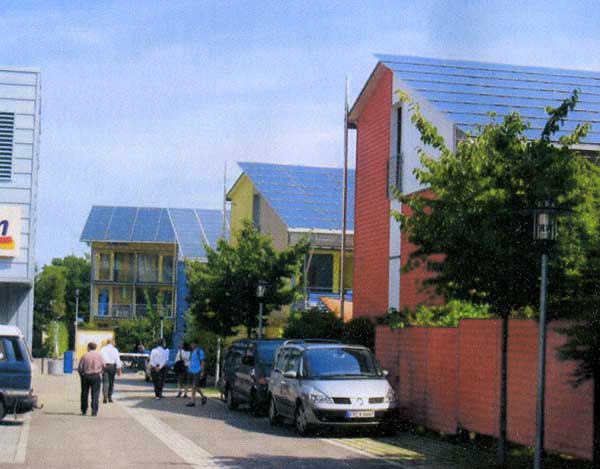
^Freiberg, Germany solar rooftop neighborhood.
What this news makes clear is that if these solar panels were to be placed on rooftops in the city, their efficiency could compete well with traditional carbon-burning power plants.
Mark Bachman, senior equity analyst for Pacific Crest Securities in Portland, Oregon, calculated that the El Dorado facility can produce power at a cost of 7.5 cents per kilowatt-hour, less than the 9-cent benchmark for conventional electricity. This could indicate the long-awaited “grid parity” threshold has been achieved, solar energy competing with efficient fuels such as coal and natural gas. The claims are that the El Dorado Energy Solar plant is producing electricity at costs below anything comparable so far in the renewables sector.
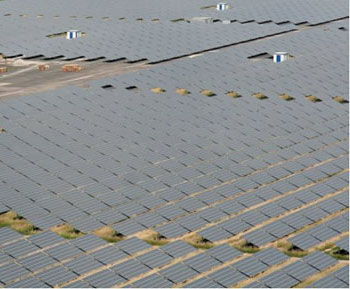 Conventional solar modules use an expensive semiconductor known as polycrystalline silicon, as in computer chips. First Solar of Tempe, Arizona, uses cadmium telluride made into thin-film cells that have cut the cost of manufacturing by 67% in the last four years.
Conventional solar modules use an expensive semiconductor known as polycrystalline silicon, as in computer chips. First Solar of Tempe, Arizona, uses cadmium telluride made into thin-film cells that have cut the cost of manufacturing by 67% in the last four years.
Sempra used First Solar’s technology on its El Dorado plant. But the panels work just as well on rooftops. Southern California Edison in 2008 placed cadmium telluride thin-film PV on a 600,000-square-foot Fontana warehouse, and plans to cover 150 more commercial buildings as well. This rooftop network would total 250 megawatts. (See more on how to relocalize our power generation >>here.)
--LMC
(From the Los Angeles Times , Las Vegas Sun, and CBS-Channel 8 News, Las Vegas)
March 8, 2009 - See the article in the Las Vegas Sun about Boulder City's plans for more solar plants here >>here.
